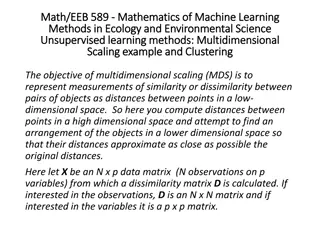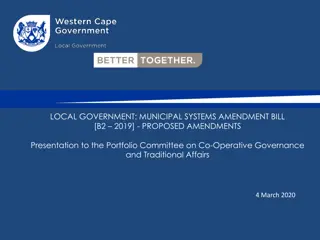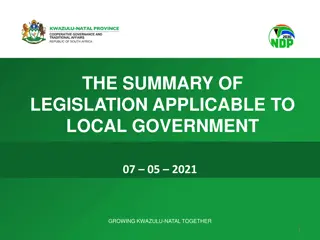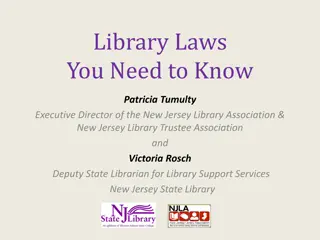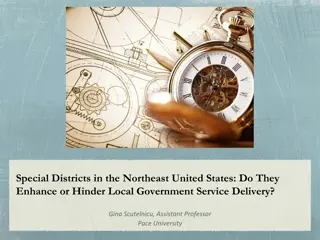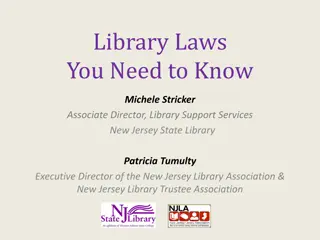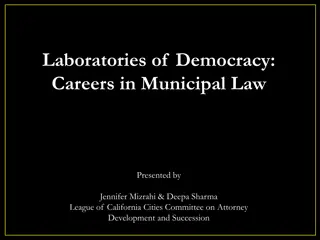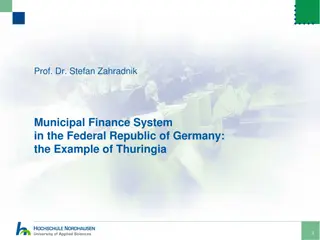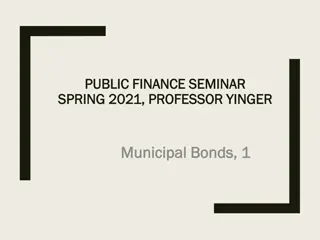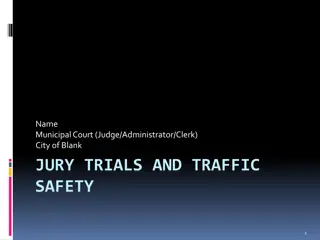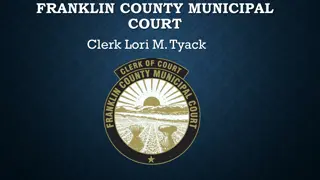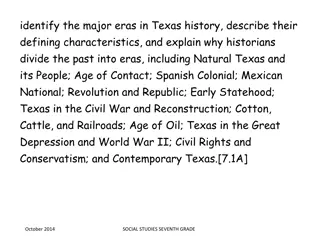Municipal Management Districts (MMDs) in Texas
Municipal Management Districts (MMDs) in Texas are special districts that are self-governed but require approval from the host municipality. They have the authority to provide infrastructure and approved service plans. MMDs can issue tax-exempt bonds, levy taxes, assessments, and impact fees, and promote various aspects of development within defined areas. The creation of MMDs involves formal application processes with involvement from the Texas Commission on Environmental Quality or the State Legislature. MMDs are self-governed political subdivisions of the state but may be subject to checks and balances by the city. They provide supplemental services while working in conjunction with municipalities.
Download Presentation

Please find below an Image/Link to download the presentation.
The content on the website is provided AS IS for your information and personal use only. It may not be sold, licensed, or shared on other websites without obtaining consent from the author.If you encounter any issues during the download, it is possible that the publisher has removed the file from their server.
You are allowed to download the files provided on this website for personal or commercial use, subject to the condition that they are used lawfully. All files are the property of their respective owners.
The content on the website is provided AS IS for your information and personal use only. It may not be sold, licensed, or shared on other websites without obtaining consent from the author.
E N D
Presentation Transcript
Municipal Management Districts (MMD) are special districts that are: Self governed, but must be approved by the host municipality; and have the ability to infrastructure and provide approved service plan. Created either: Pursuant to Ch.375, Local Government Code, through the Texas Commission on Environmental Quality (TECQ,) or by local law enacted by the State Legislature. construct public services within District 3
MMDs may issue Tax Exempt Bonds BUT bond debt is not city debt and does not impact city bonding capacity. May levy taxes, assessments and impact fees in accordance with service plan. Assessments only by petition of affected property owners and property taxes require approval by majority of eligible voters in district. Bond issuances must be approved by City Council. Often combined with TIFs to provide funding necessary to finance infrastructure improvements and supplement city s capital investments There is significant use of this tool in other areas of the State Operated in Houston since mid-1990s. Several other Texas cities have established MMDs 4
Promote, develop, encourage and maintain employment, commerce, transportation, housing, tourism, recreation, arts, economic development, safety and public welfare within a defined area. Provide and enhance supplemental services to the area. Create an independent financing mechanism to finance these services. Focused primarily on commercial development or business activity. 5
MMDs can be created in two ways: Through formal application to Texas Commission on Environmental Quality (TECQ) in accordance with the provisions of Chapter 375, Local Government Code involves nine months process serves primarily commercial development requires a petition signed by owners of a majority of the assessed real property in proposed district Through a special local bill in the State Legislature must be supported by local municipality and House/Senate authors and sponsors (four months) 6
Are Self-governed and a political sub-division of the State, but City has ability to require checks and balances in formatting State legislation. Provides complimentary and supplemental services, but does not replace services provided by municipality May levy taxes, assessments or impact fees in accordance with its approved service plan. Assessments must be requested by petition of affected property owners. Real Property Taxes must be approved by a majority of eligible voters in District. 7
Generally track Chapter 375 of Local Government Code. Initial board appointed by creating legislation/application. New appointment/reappointments recommended by governing board and approved by City Council. Four year staggered terms Board eligibility: At least 18 years old Resident or owner of property in the District Owner of stock of a corporate owner of property in District Owner of a beneficial interest in Trust that owns property in District An agent, employee or tenant of a person that owns property in the District 8
Economic Development Business Recruitment Promotion of Health and Sanitation Public Safety, Traffic Control and Recreation Landscaping, Lighting and Signs Streets, Walkways and Drainage Solid Waste, Water, Sewer and Power Facilities Parks, Historic Areas, Works of Art Parking Facilities and Transit Stations 9
May issue bonds allowed by statute and its local governing municipality Bond debt is not City debt and does not impact City bonding capacity Bond debt supported by Real Property Taxes, Assessments or Impact Fees (Assessments must be requested by petition of affected property owners.) Real Property taxes must be approved by a majority of eligible voters in District Under Chapter 375, District may not finance services and improvement projects unless petitioner requesting those services and improvement projects submitted by either owners of 50 percent or more of assessed value in district or owners of 50 percent or more of surface area of district, excluding publicly owned lands and lands exempt from assessment. 10
MMD exists until dissolved by: Petition by property owners (75%), or Vote of board Additionally the MMD may be dissolved by Resolution of City Council 11
Use Land Improvement Total Taxable Single Family $ 13,976,565 $ 64,048,154 $ 78,024,719 $ 61,395,359 Multi Family 2,059,859 9,523,908 11,583,767 11,141,349 Office 1,132,054 4,727,586 5,859,640 4,955,184 Commercial 2,622,381 6,089,685 8,712,066 8,712,066 Total $ 19,790,859 $ 84,389,333 $ 104,180,192 $ 86,203,958 12
865 residential parcels of property are in the boundaries of the potential Municipal Management District for a total appraised value of $89,608,486 Based on total appraised value in 2012, the average value per residential parcel is $103,593 40 Commercial parcels of property are within the boundaries of the potential Municipal; Management District for a total appraised value of $14,571,706 Based on the total appraised value in 2012, the average value of commercial parcels is $2,604,048 13
On the average residential parcel, every $.01 of tax assessed would create a tax liability to the owner of $10.53 On the average commercial property, every $.01 of tax assessed would create a liability to the owner of $260.05 Each $.07 of tax assessed on the entire residential district would pay for approximately $1.0 million in capital project cost 14
Full Reconstruction Roadway Reconstruction Storm Water Costs Water Costs Wastewater Costs Total $1.1018 tax rate required = $1,141per year (residential) $1.1018 tax rate required = $28,691.40 per year (commercial) $9,000,000 $4,600,000 $1,150,000 $ 900,000 $15,740,000 15
Partial Reconstruction Roadway Reconstruction Storm Water Costs Water Costs Wastewater Costs Total Mill off asphalt and partial repair of roadway base $.9128 tax rate required = $945.59 per year (residential) $.9128 tax rate required = $23,769.75 per year (commercial) $6,300,000 $4,600,000 $1,150,000 $990,000 $13,040,000 16
Proposed role of the City of Corpus Christi is: Facilitator Technical Advisor Evaluator 17
Tax Increment Refinancing Zone Tax Increment Financing, or TIF, is a public financing method that is used for subsidizing redevelopment, infrastructure, and other community-improvement projects in many countries, including the United States. Similar or related value capture strategies are used around the world. If the cost of basic services increases, with TIF in place, the result is a revenue shortfall that has to be paid from sources other than tax revenues of the TIF district. TIF is a method to use future gains in taxes to subsidize current improvements, which are projected to create the conditions for said gains. The completion of a public project often results in an increase in the value of surrounding real estate, which generates additional tax revenue. Sales-tax revenue may also increase, and jobs may be added, although these factors and their multipliers usually do not influence the structure of TIF. 18
Tax Abatement The Property Redevelopment and Tax Abatement Act, Chapter 312 of the Texas Tax Code, authorizes counties, cities and school districts to provide property tax abatement for limited periods of time as an inducement for the development or redevelopment of a property. 19
Clear identification of district boundaries Project consideration/selection More substantial modeling of cost to home owners Identification of home owner interest Briefing to City Council Consideration of Preliminary Board Composition Consideration of a Municipal Management District Service Plan Seek approval through petition to Texas Commission on Environmental Quality (Majority of the assessed value of real property in the district, or 50 persons who own real property in the proposed district) 20
Questions? 21



